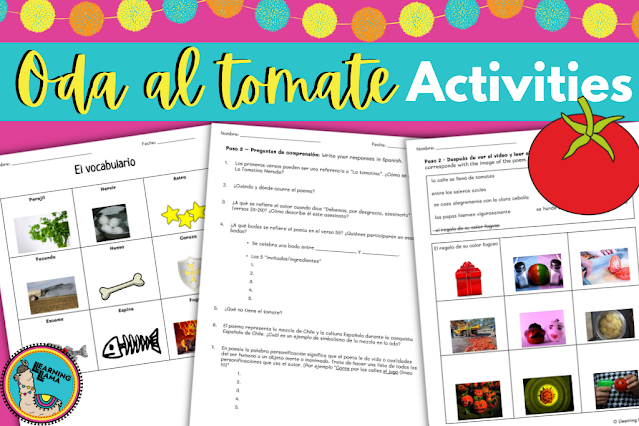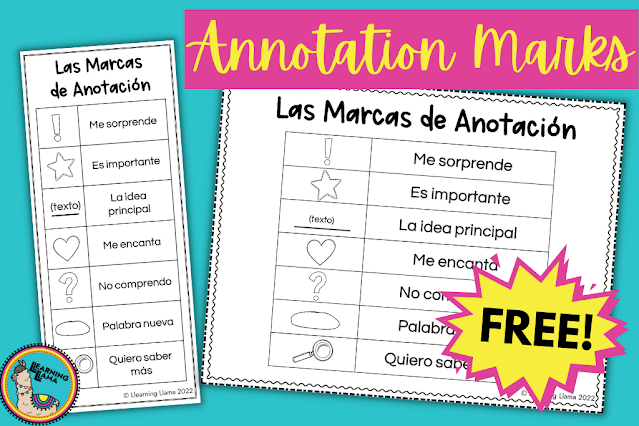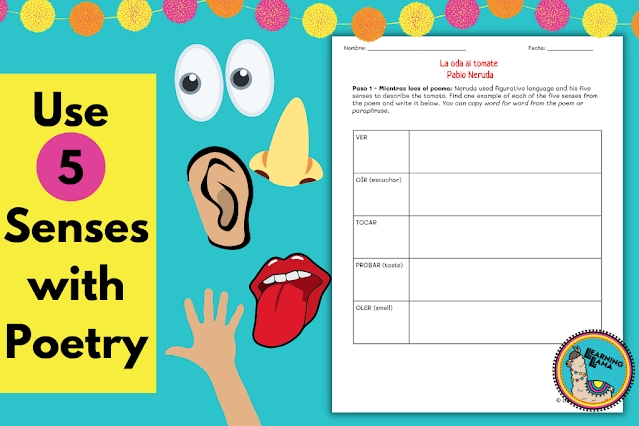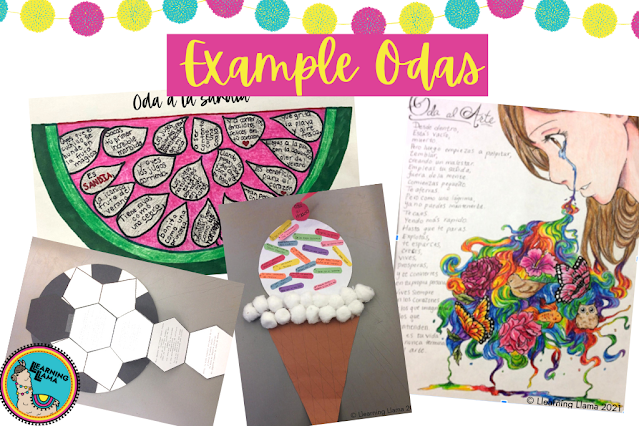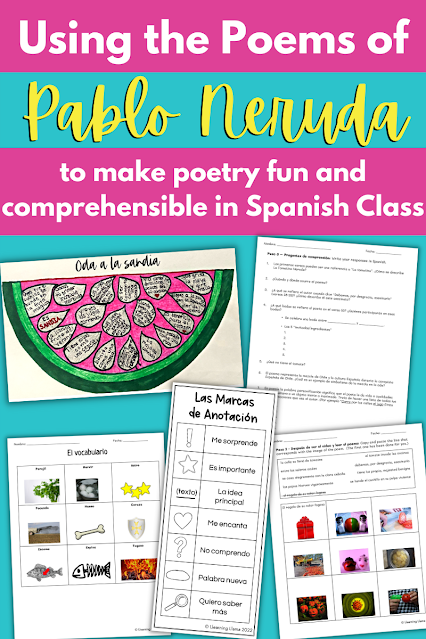One of the most famous Spanish poets is Pablo Neruda, and he is a great poet to introduce to your Spanish classes, especially intermediate to advanced level students. Teaching Spanish poetry Pablo Neruda style can be a daunting task. In the poems of Pablo Neruda, there is a lot of figurative language, a great amount of advanced vocabulary, and new grammar structures that our students haven’t seen before. But that doesn’t mean it is not comprehensible or achievable! Here are some ways to use the poems of Pablo Neruda in your Spanish classes, including pre-reading, during reading, and post-reading strategies for all of your learners.
Pablo Neruda Odes
Some of the most famous poems of Pablo Neruda are his odes to everyday objects, like dictionaries, onions, summer, or socks. An ode, or poem praising or expressing love of an everyday object is something our students can definitely get on board with. They can easily write an ode to video games, pizza, makeup, or YouTube, right?! So check out this favorite lesson of mine and get your students reading and writing poetry that they will enjoy. I’ll explain my lesson below, but you can get all of the worksheets and activities here!
Let’s start your students off by reading one (or more) of Neruda’s odes. Each Pablo Neruda ode uses such personification that it is important to slow down and really analyze the poem with your students. In the past, I’ve used “Oda al tomate” with my students. A love poem to the ordinary tomato is much more exciting and action-packed than one might expect! Here are my tips and tricks for teaching Neruda’s poetry to your students.
Pre Reading Strategies
- Before introducing any story, poem, song, or text to my students, I like to introduce them to the author first. They should get a quick background on where the author is from, what their main themes are, and what their inspiration for writing is. You don’t need to spend forever on this, just a few minutes is sufficient. You can teach your students about Neruda and other Spanish writers with these 8 mini booklets – perfect for a few quick mini-lessons over the course of National Poetry Month or National Hispanic Heritage Month.
- Prior to reading, I also pre-teach the most important vocabulary from the text. Using visuals to introduce each new vocabulary term really helped my students. They played Taboo, wrote definitions, and described images all using the vocabulary before we even jumped into Oda al tomate.
- This YouTube video of Oda al tomate is a perfect visual for students to read along and visualize the poem. You can watch it before or after reading. As students watch and listen, have them write down words they understand.
- Make sure you have numbered the lines of the poem before printing and making copies! It will make your during and post reading activities much easier if you can say “everybody, let’s look at line 14.” You’ll definitely save yourself a lot of frustration and repetition.
During Reading Strategies
- Annotate, annotate, annotate. No matter which of these reading strategies you use, they should all be accompanied by annotations. Students should have their own copy of the poem to draw on, underline, circle, and highlight. I use these annotation symbols and you can grab your free copy of the annotation markings here!
- The first time you read the poem, have students use the annotation markings to mark their immediate reactions. Did something surprise them? Confuse them? Do they want to know more?
- Encourage them to keep using the annotation tools as they complete the other reading strategies, too. Annotating is not a one and done kind of activity!
- As we read the poem a second time, I had my students fill out a chart of their five senses. How does Neruda describe the tomato? Can you hear the knife slicing through it? Can you see the visceral red color as the tomato opens on the kitchen table? Students highlight the uses of personification, citing text evidence of how the tomato is personified or “like a human.”
- I also use reading comprehension questions to guide students after they’ve read through the poem once or twice. There are certain stanzas, lines, or phrases that I want to draw their attention to, so I turn those into questions for students to focus on. For all of these worksheets, check out the entire Oda al tomate lesson.
Post Reading Activities
- Use the YouTube video that I mentioned before to have students retell the poem in their own words. Similar to a Movie Talk, you can pause the video at different points and screenshot images. Show your students those images and have them describe what is happening in the still image. They should try to use some of the new vocabulary and personification, but paraphrase in their own language.
- Illustrate the poem – Take various stanzas from the poem and have your students illustrate an image to go with it. Ideally, you could print the lines or stanzas on large paper and post them around the room. Give each group a poster paper to use as they draw a matching image for their part of the poem. Then, you can display the text and poem around the room and students can go around the class reading and “seeing” the poem.
- In “Oda al tomate”, Neruda makes a reference to Spain’s La Tomatina festival, so you could also tie this into an entire lesson on La Tomatina. Check out these 7 ways to bring La Tomatina to life in your Spanish class!
- A tomato fight – like La Tomatina, but with lines of the poem printed on red paper! Print out the poem on red paper, and cut up each line. You’ll need to type in a large font and put a few spaces between each line. Play some fun music as students have a “food fight” with their tomatoes. When the music stops, they should pick up the piece of the poem nearest to them, read it aloud, and answer one of these three questions: 1. How does this make you feel? 2. Name an element of personification in the line. 3. Which of your five senses are readers using to interpret this line?
Write Your Own Odes
- Alway start with brainstorming! Give your students a graphic organizer to get started. Again, they should be using their five senses to write their ode, so that can be the entire organizer. Once they choose an item, encourage them to close their eyes and put themselves with that object or pretend to be that object. I’ve had great success with a brainstorming session where we slowly take one sense at a time, imagine it, and write down anything that comes to mind. By narrowing our thoughts to just one sense at a time, we can block out all distractions and get the best results for each one.
- Provide students with hyperbole, simile, and metaphor vocabulary. If you want them to use personification, you have to give them examples. Writing poetry is challenging enough in your native language alone, so they may need a crutch to get started in the target language. Here are some links to teach how to write a metaphor in Spanish, a simile in Spanish, or a variety of figurative language examples.
- I also make sure to stress that this is a poem of “exaggeration.” The tomato is not really alive and running through the streets. And neither is the inanimate object they chose, but we have to imagine it is. This activity requires creative thinking.
- Students will turn their brainstorming into a final ode of their own. They will write the ode and create a drawing or presentation to go with it. One of my all-time favorite student submissions was an ode to a pillow. The student created a pillow out of paper, wrote the ode on the pillow, then made a paper pillowcase to go around it. When you pull the pillow out of the case, you get the poem! Check out some of these other creative ode presentations from my students.



